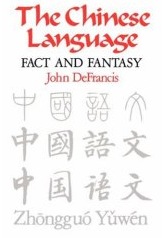The Chinese Language: Fact and Fanstasy
From Cibernética Americana
| The Chinese Language | |
|---|---|
 Cover of the paperback edition | |
| Author | en:John DeFrancis |
| Language | English |
| Genre(s) | Nonfiction |
| Publisher | University of Hawai'i Press |
| Publication date | 1984 |
| Media type | Hardcover, Paperback |
| Pages | 330 |
| ISBN | ISBN 0-8284-0866-5, ISBN 0-8248-1068-6 (paperback) |
Local Lede
Cloned en:The Chinese Language: Fact and Fantasy. See discussion page.
English Lede 2010-01-29
The Chinese Language: Fact and Fantasy is a book written by en:John DeFrancis, published in 1984 by University of Hawaii Press. The book describes some of the concepts underlying the en:Chinese language and en:writing system, and gives the author's position on a number of ideas about the language.
Main points
- There is not a unique "en:Chinese language". There is a group of related ways of speaking, which some may call en:dialects, others call en:topolects (a en:calque of Chinese 方言, fāngyán; DeFrancis uses the term "en:regionalects"), and still others would regard as separate en:languages, many of which are not mutually intelligible. One such variant, based on the speech of the en:Beijing area, has been chosen as the en:standard language in the en:People's Republic of China, and is now known as "en:Putonghua", or common language.
- The Chinese writing system has a heavy phonological basis, shown in the phonetic elements common in more than 95% of en:Chinese characters. Unfortunately they are missing from many common characters, and were removed from numerous "simplified" characters, causing many scholars to miss the point that they are a necessary resource for Chinese readers. It is not a brilliant ideographic script; it is a poor phonetic script.
- Although there are characters in the Chinese writing system that visually represent concepts, such as 一 二 三 for one, two, and three, Chinese writing is not ideographic in the sense that the symbols represent ideas divorced from language. There can be no such thing as a completely ideographic writing system, where there would be en:symbols to stand for all possible individual concepts and where en:morphemes or en:phonemes would play no significant role in writing individual words. For instance, most Chinese words are written as phono-semantic compounds that include a non-ideographic, phonetic element.
- The Chinese script, with its huge number of characters, its complexity and its irregularities, is harmful to the en:literacy improvement efforts of the Chinese society, and needs to be replaced by a more efficient en:writing system if China is to achieve the benefits of modernization.
Six myths
A good portion of the book is devoted to debunking what DeFrancis calls the "six myths" of Chinese characters. The myths are:
- The Ideographic Myth: Chinese characters represent ideas instead of sounds.
- The Universality Myth: Chinese characters enable speakers of mutually unintelligible languages to read each other's writing. (Also, to the extent this is possible, this is due to a special property that only Chinese characters have.) Furthermore, Chinese from thousands of years ago is immediately readable by any literate Chinese today.
- The Emulatability Myth: The nature of Chinese characters can be copied to create a universal script, or to help people with learning disabilities learn to read.
- The Monosyllabic Myth: All words in Chinese are one syllable long. Alternatively, any syllable found in a Chinese dictionary can stand alone as a word.
- The Indispensability Myth: Chinese characters are necessary to represent Chinese.
- The Successfulness Myth: Chinese characters are responsible for a high level of literacy in East Asian countries. (A weaker version of this myth is simply that despite the flaws of Chinese characters, East Asian countries still have a high level of literacy.)
All of these are dealt with in separate chapters, at length, in the book.
Significance and Criticism
The book is significant in a number of fields of discource, primarily linguistics of course, and its controversial theses have generated much cricitism.